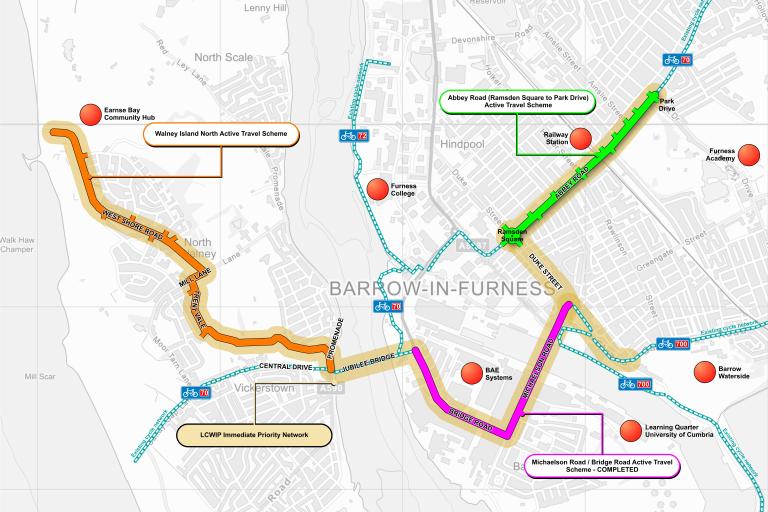Scheme feasibility and design development of routes and infrastructure identified in our:
- Local Cycling and Walking Infrastructure Plans (LCWIPs)
- Active Travel Infrastructure Strategies (ATISs)
North Walney Active Travel Scheme (ATF3)
The Council have been awarded funding through the Active Travel Fund 3 (ATF3) to develop and deliver a 2.3km cycling, walking and wheeling route on North Walney, Barrow-in-Furness.
Starting at Earnse Bay, the route follows West Shore Road and Trent Vale before running through Vickerstown Park and re-joining the highway at the Jubilee Bridge junction with the Promenade.
The route provides a continuous, safe, direct and attractive active travel link for residents of North Walney facilitating access to the town centre and providing a link to residential areas, schools and the new Earnse Bay Community Hub.

There was a public consultation on the concept or emerging preliminary designs for the scheme between the 19 May and 9 June 2023. We have analysed the responses and summarised the results in the North Walney Consultation Report (PDF , 708KB)
The preliminary designs have been finalised in the North Walney route plan (PDF , 3.4MB)
The detailed designs have been finalised in July 2024. Construction will commence in August 2024 with a six month construction period.
Abbey Road Active Travel Scheme, Barrow-in-Furness (ATF3 / #Brilliant Barrow Town Deal)
We have been awarded funding through the Active Travel Fund 3 (ATF3) and the #Brilliant Barrow Town Deal to develop and deliver improvements for pedestrians and cyclists on Abbey Road, Barrow-in-Furness.
The improvements between Ramsden Square and Park Drive will provide a safe and continuous active travel route through the town centre, connecting major employers, shops and facilities to surrounding residential areas.
There was a public consultation on the emerging preliminary designs for the scheme between the 19 May and 9 June 2023.
Feedback was sought on designs for two options (A and B). Following the consultation a preliminary design based on Option A, whereby the proposals place new uni-directional cycle lanes mainly in the existing footway space, was endorsed by Council members.
Responses to the consultation have been analysed and summarised in the Abbey Road Consultation Report (PDF , 576KB).
The preliminary designs have now been finalised in the Abbey Road route plan (PDF , 8.7MB)
We are currently finalising the detailed designs for the scheme with the aim of starting construction in the new year.
As part of our active travel cycling and walking improvement scheme, we plan to remove three street trees along Abbey Road to allow for the construction of the new cycleway and provide clear visibility to the proposed traffic signal heads on the new crossings.
The trees that are removed will be replaced with new trees after construction of the scheme has finished.
A 28-day consultation ran between 11 December 2024 to 8 January 2025. We have received no comments regarding the proposal to remove the street trees.
Please see the following notices:
Duty to consult on felling street trees: Abbey Road, Barrow (PDF , 136KB)
Duty to consult on felling street trees, consultation result: Abbey Road, Barrow (PDF , 141KB)
Bridge Road and Michaelson Road, Barrow-in-Furness (ATF2)
The scheme on Bridge Road and Michaelson Road (funded by the Active Travel Fund 2) was opened in Autumn 2022, with further improvements made in Winter 2022.
The scheme has introduced lightly segregated infrastructure and alterations to bus stops, with the inclusion of bus stop bypasses where possible.
There are also improved facilities for pedestrians, including enhancements to the existing Michaelson Road crossing and an additional signalised crossing on Bridge Road.
The introduction of a raised table at the Farm Street junction also serves as a traffic calming measure and safe crossing point.
The scheme and nearby roads have been monitored to count the number of cycle movements undertaken over seven days. Counts were undertaken in October 2021, before the scheme was constructed, and again in October 2023, one year after construction.
The monitoring has shown that the scheme has had a positive effect on the amount of cycling movements observed:
- on Michaelson Road, cycle counts increased 57% on average over the seven days. This equates to an additional 70 cycle movements on average per day. There has been a reduction in cyclists using the footways
- on Bridge Road, cycle counts have increased 27% on average over the seven day period. This equates to an additional 28 cycle movements on average per day.
Further information can be found in the Monitoring and Evaluation Report for the Michaelson Road and Bridge Road Scheme (PDF , 601KB).
Safer school streets
School Streets is a national initiative which introduces a temporary restriction on traffic, making roads outside schools into pedestrian and cyclist zones at peak times during term time.
The roads covered by a school street restriction become a walking/wheeling, scooting, and cycling zone. Traffic is restricted for up to an hour at school drop-off and pick-up times in the morning and afternoon. Local residents and emergency vehicles are exempt from the restriction.
In 2021 we (then Cumbria County Council) undertook a six-month trial, implementing experimental Traffic Regulation Orders outside five schools in Cumbria. Schools within the Westmorland and Furness Area included Askam Village Primary School, Askam-in-Furness and Sir John Barrow School, Ulverston.
The trial for Sir John Barrow School was successful with a permanent Traffic Regulation Order being put in place.